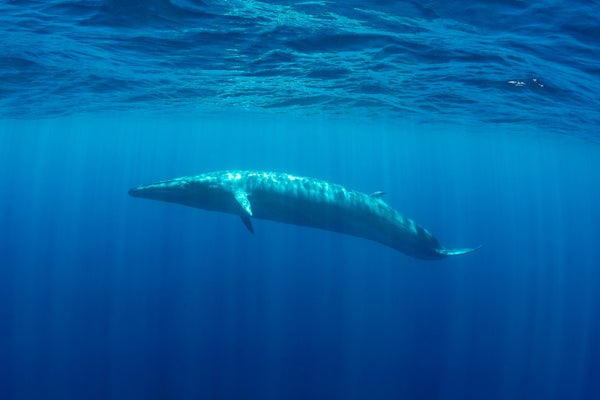September 18, 2024
3 min read
Mystery of Deep-Ocean ‘Biotwang’ Sound Has Finally Been Solved
A strange sound dubbed “biotwang” was first heard bouncing around the Mariana Trench 10 years ago, and scientists have finally figured out where it comes from

A Bryde’s whale (Balaenoptera edeni).
By Wildestanimal/Getty Images
Recorded by microphones deep in the ocean, the unexplained sound—a low, sonorous grunting followed by a squeaky, mechanical echo, like a frog burping in space—first rumbled through a computer speaker about a decade ago. Baffled researchers called it the “biotwang.”
“You’ve got this low-frequency portion, like a moan,” says Lauren Harrell, a data scientist at Google Research’s AI for Social Good, adding her own impression of a hearty groan. “Then you have the higher-frequency component that sounds, to me, like the original Star Trek Enterprise ship—the ‘bip boo, bip boo’ sound.”
Autonomous underwater gliders first recorded the odd noise echoing through the miles-deep Mariana Trench in 2014. Researchers couldn’t identify a source, but they had some theories. “There’s enough other artificial, Star Wars–sounding whale calls that they guessed it was made by a baleen whale,” says Ann Allen, a research oceanographer at the U.S. National Oceanic and Atmospheric Administration (NOAA). But she notes that “anybody who’s not familiar with whales would never think this was made by an animal.”
On supporting science journalism
If you’re enjoying this article, consider supporting our award-winning journalism by subscribing. By purchasing a subscription you are helping to ensure the future of impactful stories about the discoveries and ideas shaping our world today.
Hear the biotwang for yourself:
Confirming which marine animal makes a peculiar noise isn’t easy, though: it requires a person on a boat to see and identify the source at exactly the same time the sound is heard. “It takes a lot of time, a lot of effort and a fair amount of luck,” Allen says.
That’s how Allen, Harrell and their colleagues finally solved the biotwang mystery. While surveying whales off the Mariana Islands, an archipelago near the trench of the same name in the North Pacific Ocean, Allen and other NOAA researchers saw a mysterious species called the Bryde’s whale (Balaenoptera edeni) 10 times. These whales are spread out far across the huge open ocean, so it’s hard for scientists to observe or study them. On nine of the occasions that Bryde’s whales turned up, the researchers also heard the biotwang. “Once, it’s a coincidence,” Allen says. “Twice is happenstance. Nine times, it’s definitely a Bryde’s whale.”
After identifying the source, they reviewed years of audio data from underwater hydrophones to find out where this specific whale sound had previously been heard. But NOAA’s growing database has more than 200,000 hours of such recordings. “It’s so much data that it’s simply impossible to analyze [manually],” says Olaf Meynecke, who specializes in baleen whales as a research fellow at Griffith University in Australia and wasn’t involved in Allen’s new biotwang study, which was published on Wednesday in Frontiers in Marine Science.
When analyzing audio data for another project, Allen had been “flabbergasted” by the huge volumes of data to slog through. At one point, she says, her dad suggested, “Just get Google to do it for you.” So Allen reached out to company staff, and, to her surprise, they agreed. The company provided AI tools that helped speed up analysis by transforming audio data into an image called a spectrogram and then training algorithms to look for certain frequencies using image recognition.
The new study lays out the evidence associating biotwangs with Bryde’s whales in the western North Pacific. The data confirmed that the animals the researchers studied comprise a distinct Bryde’s whale population and showed where in the ocean they were found during different seasons and years—something that had previously been impossible because scientists couldn’t tell different populations of the mysterious whales apart. And in 2016, when a strong El Niño led to a shift in the location of the whales’ food (largely krill, sardines and anchovies), there were lots of biotwangs—even in the northwestern Hawaiian Islands, an area these whales only ventured into under certain climate conditions. This could mean that their movements are at least partially determined by their prey’s distribution, which changes with environmental conditions.
“We seem to be so detached from, or simply have no access to, this amazing acoustic underwater world. I think it’s about time that we change that.” – Olaf Meynecke, Griffith University
Once scientists know where and when these whales travel, Harrell says, AI models could “connect that data to climate and environmental factors” and thus support protection efforts. As climate change worsens and there are possible changes to El Niño and its cold-water counterpart, La Niña, “these whales will have to travel further—and they may have to work a little harder in order to find food,” Allen says.
The technology isn’t perfect. “These algorithms can only search for a frequency they know,” Meynecke says. Baleen whale vocalizations change over time and between populations. But because the tools are open-source, other scientists can use them to discover more about whale language. “We seem to be so detached from, or simply have no access to, this amazing acoustic underwater world,” he says. “I think it’s about time that we change that.”
